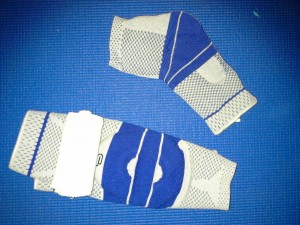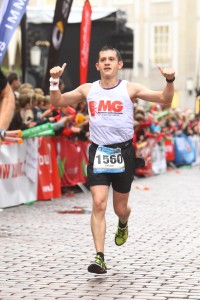Rocking on the Roads: “Injuries”
By Hector Romo-Parra

It’s a sunny day you have dressed for the occasion, wearing your running shoes and tied the shoes laces (not applicable for barefoot). After warming up you start pushing yourself towards, in a slight forward lean, while moving one leg and the opposite arm to the front, this foot strikes the ground and gives you propulsion to the front… then you do the same movements but with the opposite limbs; repeating the cycle once again and so on… As we all know here: “running is characterized by the repetition of a large number of almost identical movements with very few variations.”(1)
During this cycle our body is subject of high repetitive stress which produces small micro-trauma. These micro-trauma can be healed within a short period of time but if we stressed the body to the limits the micro-traumas can be accumulated and worsen followed by insufficient time to repair (2). Then at this point we are talking about injuries.
Running-related injuries or RRI have been defined as: ” …physical pain or complaint located at the lower  limbs or lower back region, sustained during or as a result of running practice and impeding planned running activity for at least 1 day.” (Malisoux) and are generally divided into two broad categories: 1) traumatic injuries (like fractures); and 2) cumulative micro-trauma injuries (Hammil).
limbs or lower back region, sustained during or as a result of running practice and impeding planned running activity for at least 1 day.” (Malisoux) and are generally divided into two broad categories: 1) traumatic injuries (like fractures); and 2) cumulative micro-trauma injuries (Hammil).
While running we subject the musculoskeletal system to two different types of forces: external impact forces and active forces. The external are influenced by variables related to the equipment and running surface (like: soft tissue, shoes, surface of contact, etc.) (2). On the other hand, active forces are related to the body itself and mainly determined by the movement of the runner during foot contact. Although RRIs are generally thought to be connected to impact forces, there is evidence suggesting that active forces also play a significant role in some overuse injuries (5). There is consistent epidemiological support for the role of a few aetiological factors that might influence RRI; i.e. higher mileage per week, previous running injury, higher running speed and lesser running experience. (6)
The incidence of RRI has recently been reported between 19% and 79% (7), attributable to an increase in training volume and intensity and exacerbated by internal or external factors. The most common site of lower extremity injuries was found to be the knee (7.2% to 50.0%), followed by the lower leg (9.0% to 32.2%), the foot (5.7% to 39.3%), and the upper leg (3.4% to 38.1%).
Prevention
It is important to have a slow progression in your training and also to quantify the stress of each training session.
An increase in volume should not exceed 10% per week.
The weekly long run should not exceed the one from the previous week by more of around 10 minutes.
Add some cross-training to your schedule. Swimming, biking or weight lifting are less stressful than running and help you to strength your muscles. The practice of other sports would be a protective factor as this also allows a variation of the type of stress applied to the body (Malisoux) as suggested “Runners who spend more time in others sports decrease their risk of overuse injuries, because they use different muscle groups” (Jacobs & Berson, 1986).
New surfaces like after wet ground or after the first snowfall can lead to RRI so be careful about that.
The most important thing to do is to treat not only the injury itself, but the cause of the injury. Previous running injuries are also reported to be a strong predictor for future injuries in several studies (Kretsch et al., 1984; Macera et al., 1989, 1991; Walter et al., 1989; Wen et al., 1998).
Finally, I did not aim to give any kind of advice about how to prevent or how to treat an injury. This post was simple mind to give information. If you feel pain it is better to stop stressing your body and consult a professional.
 Héctor is a runner during mornings and a Neurophysiologist during days. He lives in Germany and he runs for two motivations: his 4 year old Son who is living in Mexico and to raise funds for “The Myasthenia Gravis Association” since he has been diagnosed with this disease.
Héctor is a runner during mornings and a Neurophysiologist during days. He lives in Germany and he runs for two motivations: his 4 year old Son who is living in Mexico and to raise funds for “The Myasthenia Gravis Association” since he has been diagnosed with this disease.
If you would like to support him please go to: http://www.justgiving.com/Hector-Romo-Parra
References
1) Theisen D, Malisoux L, Genin J, Delattre N, Seil R, Urhausen A. Influence of midsole hardness of standard cushioned shoes on running-related injury risk.
Br J Sports Med. 2013 Sep 16.
2) Hreljac A. Impact and overuse injuries in runners. Med Sci Sports Exerc. 2004 May;36(5):845-9.
3) Malisoux L, Ramesh J, Mann R, Seil R, Urhausen A, Theisen D. Can parallel use of different running shoes decrease running-related injury risk? Scand J Med Sci Sports. 2013 Nov 28
4) Hamill J, Palmer C, Van Emmerik RE. Coordinative variability and overuse injury. Sports Med Arthrosc Rehabil Ther Technol. 2012 Nov 27;4(1):45
5) Messier SP, Davis SE, Curl WW, Lowery RB, Pack RJ. Etiologic factors associated with patellofemoral pain in runners. Med Sci Sports Exerc. 1991 Sep;23(9):1008-15.
6) Hoeberigs JH.Factors related to the incidence of running injuries. A review. Factors related to the incidence of running injuries. A review. Sports Med. 1992 Jun;13(6):408-22.
7) van Gent RN, Siem D, van Middelkoop M, van Os AG, Bierma-Zeinstra SM, Koes BW. Incidence and determinants of lower extremity running injuries in long distance runners: a systematic review. Br J Sports Med. 2007 Aug;41(8):469-80



